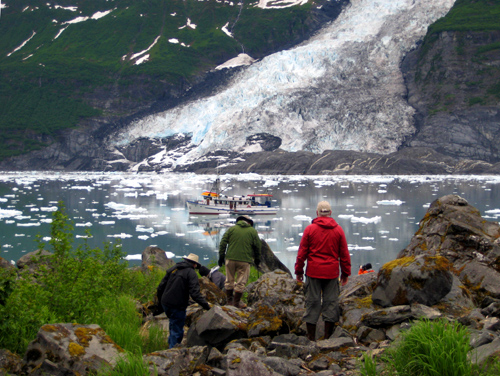 Another rain-free day. So still this morning around 730a that you could take the reflection postcards photos of the shore. But the still and slight warmth meant so many bugs that a planned kayaking trip was aborted.
Another rain-free day. So still this morning around 730a that you could take the reflection postcards photos of the shore. But the still and slight warmth meant so many bugs that a planned kayaking trip was aborted.
(We’re actually out of any internet or cell phone contact this whole week, so I’ve preposted what happened to us in previous trips.)
So after a wonderful breakfast of french toast and bacon, mixed fruits tossed in yoghurt and cranberry nut muffins, the boat sailed on. The rest of the day was dominated by the Meares Glacier at the end of the long Uniakwik fiord.
We sailed up the fiord past other fishing vessels and a fish hatchery, and began to see really quite extraordinary numbers of sea otters. Ninety percent of the world’s sea otters are found in Alaska and most of them in the Sound.
Just before lunch we turned the one corner right at the end of the sound to bring into view the Meares Glacier. Smaller than Chenega, it was still quite impressive. Stands about 100′ high and is unique for moving right up to a Sitka spruce forest. Most glaciers have been receding in the last century, so their front yard is rock face. Meares has come and gone, and the evidence is crushed forest at its edge.
After lunch we too the skiff and three dogs and went ashore. There had been a trail which had been wiped out by the most forward movement of the glacier, but we managed to find a stream bed that took us up the mountain slightly and then intersected a bear trail which took us to almost the very face of the glacier.
At that height the view was impressive, and we watched crazy Happy Dog retrieve little icebergs from 50′ below a sheer cliff face and bound back up with them. And we watched, of course, the glacier calving, which is an endlessly fascinating activity.
Glacier calving will never be an Olympic sport, and it’s darn hard to explain to those who haven’t experienced what’s so special about it. I think first that it’s the sheer power that’s being displayed when so much ice crashes into the sea.
And the crash, which resounds and echoes and booms like nuclear explosions, appears slow motioned from where you can usually view it – far enough away not to be tsunamied to death. The ship continued into a little cove with an absolutely beautiful waterfall. Most of us got on the skiff to go take a closer look, and then a quick moment for photos and back to the boat.
Dinner was a sumptuous piya of halibut, prawns (shrimps), mussels and bunches of other things and was magnificent. During dinner large glaciers calved and Dean had to point the boat into the swells.
After desert of raspberry creme brulee, Captain Dean moved very slowly through great ice peppered with dozens if not more sea otters.